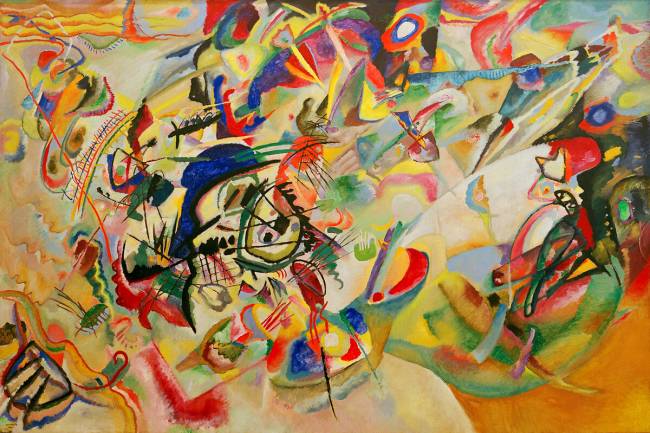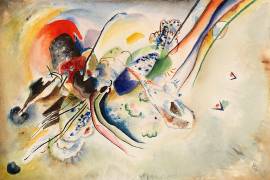Shop art print and framed art Composition No. 7 by Wassily Kandinsky
Customise
Your art print
Composition No. 7 OF Wassily Kandinsky
Composition No. 7
Composition VII: A masterpiece of abstraction
Composition VII, painted in 1913 in Munich, is considered the pinnacle of Vassily Kandinsky's pre-war period and a pivotal work in the history of abstract art. Its creation was a long and complex process, occupying the artist for much of the year. Kandinsky produced numerous preparatory drawings and watercolors, as well as six oil-on-canvas studies, testifying to his intensive quest to achieve perfect harmony between shapes and colors. This monumental work, with an imposing size of 200 x 300 cm, is today preserved at the National Tretyakov Gallery in Moscow. Composition VII follows on from the previous Compositions, notably V and VI, all three exploring the themes of the Resurrection, the Flood and the Last Judgment, but is distinguished by greater formal freedom and an explosion of vibrant color. Along with the other two paintings in the series, this canvas marks a radical turning point in the artist's career, as he definitively moves away from figuration to explore the expressive possibilities of pure abstraction
.Composition VII: A whirlwind of shapes and colors
Composition VII presents itself as a dynamic whirlwind of shapes and colors. The eye is immediately drawn to the complexity of the composition, where lines, geometric and organic shapes intertwine in ceaseless movement. Patches of bright colors - yellows, reds, blues and greens - are juxtaposed and superimposed, creating an effect of depth and light. Thick black lines run through the whole, structuring the composition and guiding the eye through this apparent chaos. Kandinsky uses a wide variety of pictorial techniques, impastos, glazes, drips, which give the canvas a rich, vibrant texture. The work gives an impression of perpetual movement, as if shapes and colors were animated with a life of their own.
The theme of Composition VII: The Last Judgment
Although Composition VII is an abstract work, it is not devoid of subject matter. In it, Kandinsky evokes the theme of the Last Judgment, an allegory of the artist's inner feelings about this passage from the Bible. This work, which evokes chaos, is a representation of the Apocalypse. The painter himself confirmed in his writings that this painting was a "representation of the beginning and end of the world". The Flood, the Last Judgment and the Resurrection are the three themes that emerge from this work.
.The composition of this painting is complex, with a multitude of shapes and colors intertwining. Colors are vivid, circular shapes and curved lines dominate, creating an impression of movement and dynamism. Kandinsky thus translates into pictorial language a cosmic vision of human history, marked by cycles of destruction and regeneration.
Symbolism of color and form in Composition VII
Each color and form in Composition VII has its own symbolic meaning, according to a "visual grammar" developed by Kandinsky in his work The Spiritual in Art. Blue, the color of heaven and spirituality, represents peace and infinity. Yellow, the color of the sun and joy, symbolizes divine energy and light. Red, the color of blood and passion, evokes strength and dynamism. Green, the color of nature, represents growth and harmony. Geometric shapes, such as circles and triangles, are associated with ideas of perfection and balance, while organic forms evoke the natural world and human emotions. Kandinsky uses these elements as a universal language to express ideas and feelings that transcend words.
Impact and legacy of Composition VII on art
Composition VII marks a turning point in Kandinsky's career and in the history of art. It established the artist as one of the pioneers of abstraction and paved the way for new forms of artistic expression. The work had a considerable impact on twentieth-century art movements, notably abstract expressionism and informal art. Today, it is a foundation for contemporary artists, thanks to its expressive power and creative freedom. Composition VII is more than just a painting; it's an invitation to a spiritual journey through color and form, an aesthetic experience that touches the soul and opens the mind to new horizons.
This artwork is a painting from the modern period. It belongs to the abstract art styles and expressionism styles.
« Composition No. 7 » is kept at Tretyakov Gallery, Moscow, Russia.



































